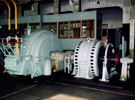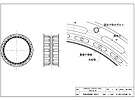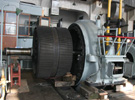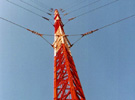Steel Towers, Control Room
In addition to the High Frequency Generator and other transmitting equipment, the Yosami Radio Transmitting Station was known for specially designed station buildings, and most of all the lofty eight steel towers of 250 meters high, standing on the plain ground called the Yosami Plain named after the name of Yosami Village. The eight steel towers were referred as the “Tallest in the East,” following the 312m-high Eiffel Tower constructed in 1889 in the West. The signals were transmitted from the antenna wires stretched over the tips of those eight steel towers.
Steel Towers
The height of 250 meters of the eight steel towers was set for the transmitting capacity toward Europe. The meter-ampere of 120,000, or 200m times 600A, was thought to be required for VLF transmitting, and by the transmitter’s capability and ampere employed, the effective antenna height of 200 meters was required and thus the height of steel towers was reportedly determined as 250 meters.
Meter-ampere = The antenna height in meters x the number of amperes at antenna wires
Following the construction start of the Office Building in 1927, the construction of the eight steel towers was started in January, 1928, by Ohkura Construction, current Taisei Corporation. The design was made by Sen-no-suke Kusunoki of Japan Wireless Telegraph Company, and the towers were made by Ishikawajima Shipbuilding Company, current IHI. The towers were stood upright in June, and the antenna wires were to be stretched. Workers riding in bamboo cages at such a dazzling altitude stretched the 16 lines of antenna wires over the eight steel towers. The workers came from Fukushima Prefecture, north Japan, where they had worked for the construction of the Hara-no-machi Radio Transmitting Station to the U.S. completed in 1921. (Photo 1: Steel Tower, Figure: Profile of the Steel Tower)
The steel tower had a shape of triangular prism of three sides of 3 meters each, and supported by wire ropes at six stages in three directions. The base, supporting the 300-ton steel tower, were laid out by three sections made by a set of four pillars made by four-lain cylindrical insulators each to insulate the ground and the tower. The quality insulators used were made in Kyoto, Japan, in stead of German made that was suggested by Telefunken. (Photo 2: Tower Base)
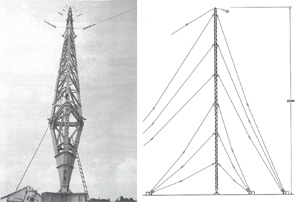
Photo 1: Steel Tower, Figure: Profile of the Steel Tower
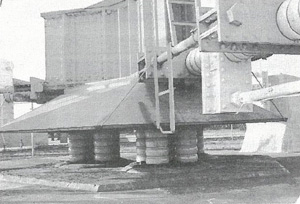
Photo 2: Tower Base
Antenna System
The eight steel towers of 250 meter high stood in two lines of a distance of 500 meters with a distance of 480 meters between towers in line. The 16 lines of antenna wires of 1,760 meters each were stretched over the eight steel towers in the sky along the two lines of the towers. The 16 lines of antenna wires were hung over the four wire lines connecting the tips of two towers each, and extended in the reverse L shape, while the earth wires were stretched like a mesh under the ground of 1,760m × 880m of the steel towers. (Photo; Figure)
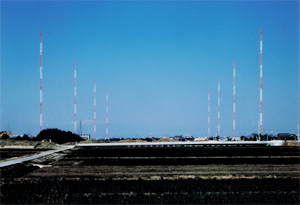
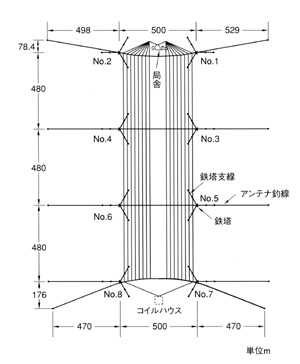
The steel towers of Yosami, the talk of the Town
The lofty eight steel towers of 250 meters high, standing on the Yosami Plain were referred as the “Tallest in the East,” and one of the tallest structures in the world, making them as the talk of the town. The position of the tallest tower in Japan was yielded 30 years later to Tokyo Tower built in 1958. The Yosami Radio Transmitting Station and its eight steel towers drew attention as facilities for wireless communications between Japan and Europe. The steel towers were sung in the school songs of nearby elementary schools, and picture post cards of the Station were issued.
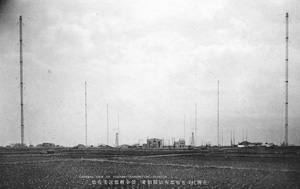
The steel towers were able to be observed as far as some dozens of kilometers such as Iwazu and Tahara in Aichi Prefecture, and the steel towers of Yosami were regarded as the landmark of Kariya. After the Short Wave Station nearby was built in 1939, some 100 shorter steel and wooden antenna towers the talk of the town. (Picture post card)
Control Room and Control Panels
The Control Room to monitor the transmitting operation was set next to the High Frequency Generator and other transmitting equipment. Two sets of Control Panels, one for current use and the other for auxiliary one, were installed, and equipment monitoring and resistance control were conducted there, while the high frequency ammeters were, due to their high voltage, read by using opera glass. Distribution board, incoming panel, keying relay were also installed.






